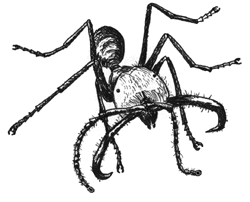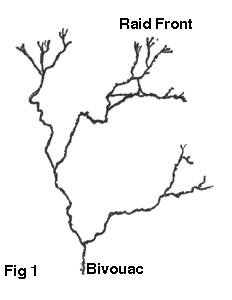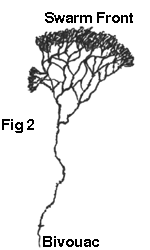Army ant colonies, like most ant colonies, have a single queen ant who lays all the eggs and female workers that tend the young and collect food for the colony. One of the things that make army ants even more interesting is how much food they require and how they get it.

Eciton burchelli soldier
Army ants belong to one of the subfamilies of ants called the Dorylinae, after the Greek word meaning 'spear'. There are approximately 150 species of army ant found mostly in the tropical and subtropical regions of Central and South America. There are also 100 other species in the 'Old World' (Africa, Australia and the Orient) sometimes called 'Army Ants' but more usually known as 'Driver Ants'.
Three incredible things you should know about army ants:
They have huge colonies
For example one species, Eciton burchelli from South America, may have a colony containing over a million ants. Each colony consists of a single (wingless) queen, a brood of developing young and a large population of adult workers.
Only the Queen and the males have eyes, the workers are all blind and rely on chemical trails to find their way around.
Some 'Driver Ant' colonies contain over 20 million individual ants!
They are carnivorous
They feed on other arthropods, mainly other insects which they capture by highly organised group raids. Some species have been seen to eat small vertebrates such as lizards and snakes. The amount of food caught is tremendous: workers of Eciton burchelli may capture more than 100,000 arthropods a day to feed the colony. The workers charge along the surface of the ground or along underground channels (depending on the species) and follow chemical trails laid down by the ants themselves. All the time huge soldier ants with massive jaws watch over the workers and protect them. The jaws of the soldiers are so huge that they are unable to feed themselves and must rely on workers to give them all the nourishment they need. Different army ant species use different types of raiding pattern. The two types of pattern are column raids and swarm raids. Eciton hamatum and Eciton burchelli are the two species of army ant that have been studied the most. Both species begin raiding at dawn with ants pouring out of the nest/bivouac but use different raiding systems.
Column raiders
E. hamatum is a column raider. The ants produce branching trails by dividing into small foraging groups, forming a tree like pattern (See Fig 1). Each trail has a two way stream of ants running along it, some ants are advancing whilst some are returning with prey. The ants may travel over 350m from the bivouac in a raid, though it depends on the type of terrain and the condition of the colony. They often invade the nests of other social insects (but not other army ants!!) and steal their brood.

Swarm raiders
E. burchelli is a swarm raider. Great crowds of raiders sweep along the ground like a dragnet flushing out a huge variety of prey (See Fig 2). A fan shaped network of columns trail behind and in the rear there is a base column connecting the raiders with the bivouac. Swarmers have stronger bites and more potent stings than column raiders and they attack a wider range of prey, including hard bodied arthropods.
Driver ants have been known to kill and dismember chickens, goats and even pigs if the animals have been injured or unable to escape the marauding ants!

They migrate
Due to their large colony size and carnivorous habits army ants must migrate in order to find enough food. The ants form only temporary nests and after raiding the whole colony emigrates to a new nest site unless it is in a 'statary' condition (the larvae in the colony are entering a pupal stage by spinning their cocoons and the enormous queen is laying eggs).
The 'nests' of army ants are not like those of other ants; they are made out of the ants themselves. They are therefore referred to as 'bivouacs' describing the resting state of the colony rather than a physical nest structure. The ants cluster together to form walls and fasten onto each other using their mandibles and claws on their legs.
So next time your picnic is interrupted by a few black ants consider yourself lucky that you don't live in the tropics where you could be carried off as well as your sandwiches!
Originally published in the Amateur Entomologists' Society Bug Club MagazineBack to example articles.
![Amateur Entomologists' Society home page [Logo]](/images/aes-logo-wplant.gif)
